
Centipedes are predatory arthropods belonging to the class Chilopoda of the subphylum Myriapoda, an arthropod group which also includes millipedes and other multi-legged creatures. Centipedes are elongated segmented (metameric) creatures with one pair of legs per body segment. All centipedes are venomous and can inflict painful bites, injecting their venom through pincer-like appendages known as forcipules. Despite the name, centipedes can have a varying number of legs, ranging from 30 to 382. Centipedes always have an uneven number of pairs of legs; no centipede has exactly 100 legs. Like spiders and scorpions, centipedes are predominantly carnivorous.

Cynognathus is an extinct genus of large-bodied cynodontian therapsids that lived in the Middle Triassic. It is known from a single species, Cynognathus crateronotus. Cynognathus was a 1.2-metre long predator closely related to mammals and had a southern hemispheric distribution. Fossils have so far been recovered from South Africa, Argentina, Antarctica, and Namibia.
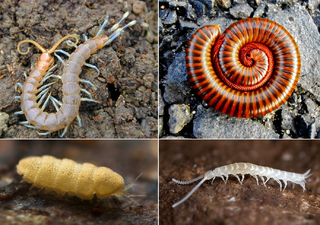
Myriapoda is a subphylum of arthropods containing millipedes, centipedes, and others. The group contains about 13,000 species, all of them terrestrial.

Titanosaurus is a dubious genus of sauropod dinosaurs, first described by Richard Lydekker in 1877. It is known from the Maastrichtian Lameta Formation of India.

The Mazon Creek fossil beds are a conservation lagerstätte found near Morris, in Grundy County, Illinois. The fossils are preserved in ironstone concretions, formed approximately 309 million years ago in the mid-Pennsylvanian epoch of the Carboniferous period. These concretions frequently preserve both hard and soft tissues of animal and plant materials, as well as many soft-bodied organisms that do not normally fossilize. The quality, quantity and diversity of fossils in the area, known since the mid-nineteenth century, make the Mazon Creek lagerstätte important to paleontologists, in attempting to reconstruct the paleoecology of the sites. The locality was declared a National Historic Landmark in 1997.

Ornithocheirus is a pterosaur genus known from fragmentary fossil remains uncovered from sediments in the UK and possibly Morocco.

Bothriospondylus is a dubious genus of neosauropod sauropod dinosaur. It lived during the Late Jurassic.
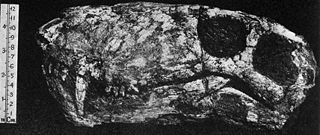
Gorgonops is an extinct genus of gorgonopsian therapsids, of which it is the type genus, having lived during the Late Permian (Wuchiapingian), about 260–254 million years ago in what is now South Africa.

Lapparentosaurus is a genus of sauropod dinosaur from the Middle Jurassic. Its fossils were found in Madagascar. The type species is L. madagascariensis.

Leanchoilia is an megacheiran arthropod known from Cambrian deposits of the Burgess Shale in Canada and the Chengjiang biota of China. It was about 5 centimetres (2.0 in) long and had long, whip-like feelers mounted on frontal arm-like appendages. Its internal organs are occasionally preserved within the substrate in three dimensions.
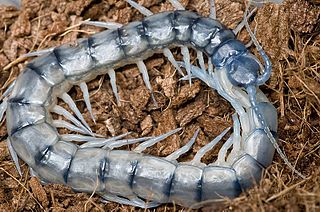
Scolopendra is a species-rich genus of large tropical centipedes of the family Scolopendridae.

Rhyniognatha is an extinct genus of arthropod of disputed placement. It has been considered in some analyses as the oldest insect known, as well as possibly being a flying insect. Rhyniognatha is known from a partial head with preserved mouthparts from the Early Devonian aged Rhynie chert around 400 million years old, when Earth’s first terrestrial ecosystems were being formed. The type, and only species is R. hirsti, which was named and described in 1928. Other analyses have interpreted the specimen as a myriapod.
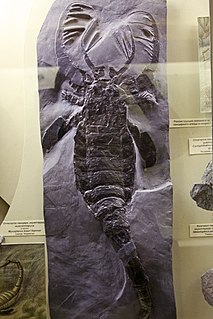
Mixopterus is a genus of eurypterid, an extinct group of aquatic arthropods. Fossils of Mixopterus have been discovered in deposits from Late Silurian age, and have been referred to several different species. Fossils have been recovered from two continents; Europe and North America.

Lycopsis is an extinct genus of South American metatherian, that lived during the Miocene in Argentina and Colombia.

Robert Latzel was an Austrian myriapodologist and entomologist who published a series of pioneering works on millipedes, centipedes, and allies. His collection of myriapod specimens, today housed in the Natural History Museum of Vienna, includes many type specimens. His monographs on the myriapods of the Austro-Hungarian Empire were the first comprehensive treatments of the large region's centipede and millipede faunas. He named nearly 130 taxa of millipedes and over 40 centipede groups, as well as four taxa each of pauropods and symphylans. His work on millipedes pioneered the use of gonopods in millipede classification and species recognition. At least three authors have honored Latzel by naming a genus Latzelia.

Slimonidae is a family of eurypterids, an extinct group of aquatic arthropods. Slimonids were members of the superfamily Pterygotioidea and the family most closely related to the derived pterygotid eurypterids, which are famous for their cheliceral claws and great size. Many characteristics of the Slimonidae, such as their flattened and expanded telsons, support a close relationship between the two groups.
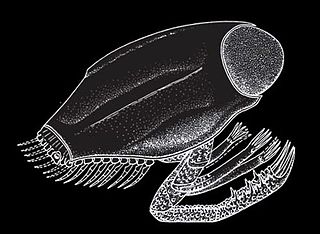
Dollocaris was a genus of Thylacocephalan that lived during the Jurassic period. Fossils have been found in France, specifically the La Voulte-sur-Rhône lagerstätte. It is known for its massive compound eyes, giving Dollocaris a rather characteristic appearance. One species is currently known, D. ingens.
Eogeophilus is an extinct genus of geophilid centipede that was discovered in the Nusplingen Limestone of Germany. It is a monotypic genus, with only type species Eogeophilus jurassicus known.

Trachytherus is an extinct genus of mammal, belonging to the suborder Typotheria. It lived during the Late Oligocene, and its fossilized remains were discovered in South America. It was a member of the extinct family Mesotheriidae, of which it was a basal member.


















